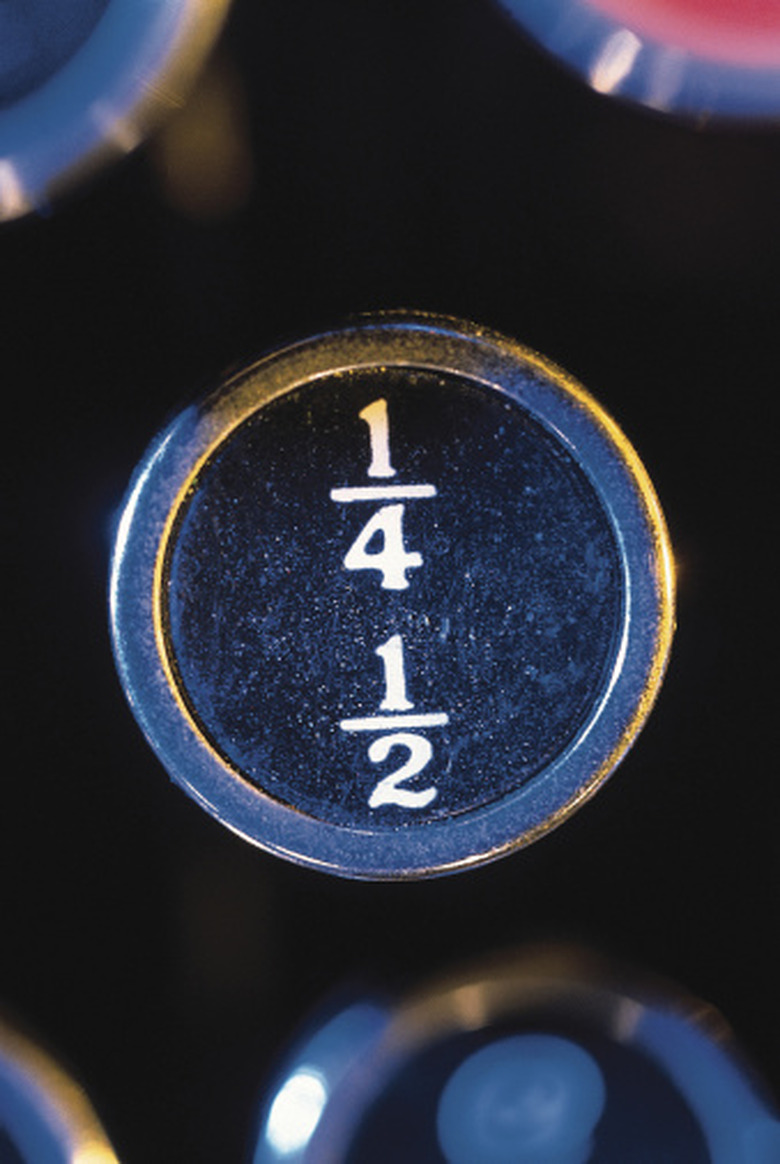Step By Step Instructions On Math Fractions
Fractions cause anxiety for many students regardless of age or math level. It's understandable; forget just one of the many steps — even if it's the simplest — and you get a missed point for the entire problem. Following step by step instructions for fractions will help you to get a handle on the many rules to combine fractions with math properties and will illustrate how those rules influence fractions.
Find a Common Denominator
Step 1
Examine the expression 3/6 + 1/8. These fractions identify two different groups, sixths and eighths and cannot be added or subtracted. They must have a common denominator; that is, be of the same group.
Step 2
Write the multiples of 6. Multiples are numbers that six times another number equals, for example, 2 x 6 = 12. More multiples of 6 include 18, 24, 30 and 36.
Step 3
Write the multiples of 8: they include 16, 24, 32, 40 and 48.
Step 4
Look for the lowest number that 6 and 8 have in common. It's 24.
Step 5
Multiply the numerator and denominator of the first fraction by 4 because you multiplied 6 times 4 to get 24: 3/6 = 12/24.
Step 6
Multiply the numerator and denominator of the second fraction by 3, again because 8 x 3 = 24: 1/8 = 3/24.
Step 7
Rewrite the expression with the new denominators: 12/24 + 3/24. Now that the denominators are the same, you can proceed with the addition process.
Add and Subtract Fractions
Step 1
Examine the problem 3/4 + 2/4. Because the denominators are the same, you can add the fractions.
Step 2
Add the numerators: 3 + 2 = 5.
Step 3
Write the sum of the numerators over the original denominator: 5/4. This is an improper fraction. Leave the answer as is or turn it into a mixed number by dividing the numerator by the denominator. Write the quotient as the whole number and the remainder as the numerator over the original denominator: 5 ÷ 4 = 1 and 1/4.
Step 4
Examine the problem 5/8 – 3/8. Again the denominators are the same.
Step 5
Subtract the numerators: 5 – 3 = 2.
Step 6
Write the difference over the original denominator: 2/8. Because both the numerator and denominator are multiples of 2, reduce the fraction to its simplest form.
Step 7
Divide both parts of the fraction by 2: 2 ÷ 2 = 1 and 8 ÷ 2 = 4. Therefore, 2/8 reduces to 1/4.
Multiply and Divide Fractions
Step 1
Examine the problem 5/7 x 3/4. The denominators do not have to be the same for multiplication and division.
Step 2
Multiply the numerators, 5 x 3, and the denominators, 7 x 4.
Step 3
Write the products as a new fraction in the solution: 5/7 x 3/4 = 15/28.
Step 4
Examine the problem 4/5 ÷ 2/3. This is called a complex fraction, which needs to be simplified in hopes of reducing the denominator of the second fraction to the number one.
Step 5
Flip the second fraction and change the property to multiplication: 4/5 x 3/2.
Step 6
Multiply straight across the fractions: 4/5 x 3/2 = 12/10. Reduce the answer by dividing both parts by 2: 6/5. Alternatively, you can do the following: Notice that the numerator of the first fraction and the denominator of the second fraction are both multiples of 2. Cross out the numerator, divide it by 2 and write the remainder in its place: 2/5. Then cross out the denominator, divide it by 2 and write the remainder in its place: 3/1. This is called in-problem reducing. It simplifies the denominator of the second fraction to 1, and eliminates the need to reduce later.
Step 7
Multiply straight across: 2/5 x 3/1 = 6/5
Cite This Article
MLA
Fuller, Tuesday. "Step By Step Instructions On Math Fractions" sciencing.com, https://www.sciencing.com/step-step-instructions-math-fractions-8507549/. 24 April 2017.
APA
Fuller, Tuesday. (2017, April 24). Step By Step Instructions On Math Fractions. sciencing.com. Retrieved from https://www.sciencing.com/step-step-instructions-math-fractions-8507549/
Chicago
Fuller, Tuesday. Step By Step Instructions On Math Fractions last modified August 30, 2022. https://www.sciencing.com/step-step-instructions-math-fractions-8507549/
